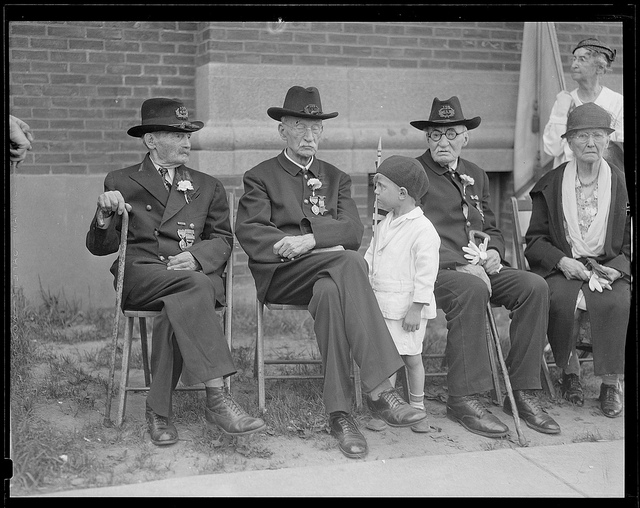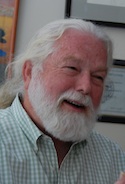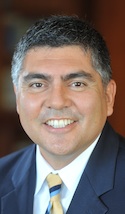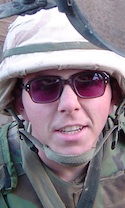
The wars in Iraq and Afghanistan are winding down. The country is cutting defense spending. So a new wave of veterans is leaving the military and returning to our communities. In light of this change, and in advance of “How Are Veterans Changing America?” a Zócalo/UCLA event, we asked veterans and those who work with veterans: What’s special about today’s generations of veterans in comparison to previous ones?
Larry Braue
Comparisons to previous generations are unfair because the nature of the military has changed

Everyone wants to compare this generation of veterans with past generations (Vietnam, World War II, and Korea). While I believe today’s veterans are clearly the “Next Great Generation,” I feel it is unfair to make that comparison. The circumstances surrounding service have changed so dramatically since World War II and Vietnam.
Today’s all-volunteer military has extremely diverse demographics and has faced a 12-year war, America’s longest. The number of women actively engaged in combat operations has grown exponentially, creating a new paradigm of an American soldier. In addition, breakthroughs in technology have spared lives of service members who would have died in previous wars, leaving them to adapt to lives with disabilities.
I have been working with veterans at the University of South Florida for more than three years and the one thing I’ve discovered is every veteran is special. Each one has different needs, issues and aspirations. Veterans from all generations are resilient, hardworking, motivated, and talented. Although I believe it has been important to emphasize the growing mental health needs of our veterans, labels such as PTSD and TBI have made potential employers leery of hiring veterans.
In order to make today’s veterans “The Next Great Generation,” we need to educate our employers about the realities of PTSD/TBI and other war related injuries. To have a great future as a nation, we need today’s veterans actively engaged in business, education, and politics. We owe these men and women a debt of gratitude. The very least we can do is give them a job and help them start the next phase of their life. We have a moral obligation to take care of our veterans. Let’s stop talking about it … and just do it!
Dr. Larry Braue served 27 years in the United States Army and holds a doctorate in Education from Liberty University.
Peter B. Hilton
The special difficulties of transition for today’s experienced, technologically savvy soldiers

Racism is subtle and toned down, but still prevalent. So is discrimination against returning GIs. It is easy to feel, yet difficult to pin down. After 9/11, and the fife and drum extravaganza that followed, many young men and women went into the service with the same sort of patriotism and sense of adventure that we did in the early years of Vietnam. Soldiers have returned to a more positive public acceptance—but that reaction has not been mimicked in the workplace.
The economic downturn that followed closely on the heels of the huge military build-up (and the costs of invading other countries while neglecting local infrastructure) has made employers cautious. Posttraumatic stress disorder (PTSD) is no longer a new diagnosis. Veterans have demonstrated difficulties in reintegrating into civil society. Hiring a returning vet may cause disruption and bring medical expenses for an employer. Military training is not the traditional training for peacetime workers. Choosing to serve in the military may be an indication of other difficulties in the home or in the background of the returning soldier. Openings are few, so why take any risks to the bottom line?
In 2008, Saint Xavier University began to participate in the Yellow Ribbon Program, a federal effort to help former soldiers reintegrate into civilian society. The university provides financial, advising, academic, and social support for these former warriors. Veterans are encouraged to seek the level of assistance needed. Currently we have about 80 veterans enrolled.
These soldiers want things to happen quickly. They are used to technology that makes things available when they need it. They are impatient and sometimes intense. They need to meet course requirements that may seem beneath the experienced soldier. Often, in the military, their experiences put them in over their heads and yet they survived. Doesn’t that indicate that they know what to do even without reading the text or completing the assignments? Besides, classes are slow-moving and mundane.
Peter B. Hilton, Ph.D., is host of WXAV’s Veteran Matters program and works at Saint Xavier University as associate professor of education and instructor in both the Graduate Reading Program and the Master of Arts in Teaching and Leadership.
José Luis Santos
Some need extra help in education and transition, but they could be a huge net benefit to society

The Serviceman’s Readjustment Act of 1944, more commonly known as the GI Bill, has provided educational assistance to millions of service members. Between 1944 and 1949, approximately 2 million World War II veterans used the GI Bill to attend college or receive other educational training. According to the American Council on Education, there are more than 2 million service members that have participated in the conflicts of Iraq and Afghanistan. Many of these returning veterans will seek access into the labor market and postsecondary education after fulfilling their military obligation.
Today, the Post-9/11 GI Bill is generous and provides financial support for education and housing to individuals with at least 90 days of aggregate service after September 10, 2001, or individuals discharged with a service-connected disability after 30 days—veterans must have received an honorable discharge to be eligible for these benefits. Additionally, service members enrolled in the new GI Bill program can transfer any unused financial support to their eligible dependent.
In a time when tuition at colleges and universities has rapidly increased, the magnitude of the Post 9/11 GI Bill enables many veterans to attend college with less concern for affordability than their non-veteran counterparts. If veterans and their families take up this benefit, matriculate, and graduate from colleges and universities, it may have the effect of creating many positive spillover effects such as the generation of our next teachers, entrepreneurs, high skilled laborers, physicians, and the like.
To leverage the Post 9/11 GI Bill investment in our veterans and derive the huge potential gains of the educational benefit, we must help our veterans develop a “civilian” identity to help them transition into the labor market and colleges and universities. Because my research shows that, on average, veterans come from households with lower parental education levels and anticipate needed tutoring or remedial work compared to their civilian counterparts, it is important for colleges and universities to support these veterans by providing necessary academic services to ensure persistence and graduation.
If colleges and universities take advantage of veterans’ ability to lead, set goals and accomplish their objectives, and if those institutions provide the necessary scaffolding for their academic success, society will reap the benefits of this era’s veterans.
José Luis Santos is an assistant professor with the Department of Education at UCLA. His work centers on higher education finance, policy, access, and higher education outcomes for underrepresented minorities and Veterans. His work can be found in top tiered journals. Also, Dr. Santos is an Operation Desert Storm Veteran who served in the United States Marine Corps.

“Today’s veterans are inventing new ways to heal.” That’s what Ami Blue—Journal of Military Experience scholarship editor, US.. Army Veteran, and Michigan State University PhD student—said last summer during the first Military Experience and the Arts (MEA) Symposium.
At MEA, we provide veterans with safe communities and workshops where they receive skilled mentorship and assistance in creative expression. Writing and art give traumatized veterans a structured means for examining painful memories, helping them understand the symptoms of war’s invisible wounds—intrusive thoughts, anger, hypervigilance, etc.—which, I believe, are the brain’s way of putting a person back into the moment of a trauma.
Why would the brain want to re-experience trauma? The answer is that, for traumatized veterans, it doesn’t feel like a “re-experiencing.” The symptoms of PTSD are more like a skipping record: each playback results in the experience of trauma for the first time. The brain, in the midst of combat or a near-death experience, can’t fully comprehend the emotional consequences of those events. Symptoms suggest that mental illness is the mind’s effort to make emotional pathways that should have been made during the event(s).
Processing symptoms and disorganized memories is crucial to healing. But traditional treatments—evidence-based therapies and psychiatrics offered by the VA—don’t always work. The impediments to processing the trauma, and creating a narrative from it, are many: two-month gaps between appointments, limited time during sessions due to patient overloads, overmedication, and the traumatized mind’s tendency to resist treatment. In response, veterans are creating narratives on their own. The proliferation of veterans’ arts and writing communities in the wake of Iraq and Afghanistan proves it.
How are veterans changing America? By healing in places everyone can see. By taking pain and molding it into stories and works of art that educate, not only about war, but also about a generation of service men and women who, after being disregarded for more than a decade, are blasting their experiences and traumas over loudspeakers for everyone to hear. Veterans are changing America by embracing a form of healing that just so happens to send a message, “No matter how rich or powerful a country becomes, sending young men and women to war will never be without consequence.”
Travis L. Martin is twice an Iraq War veteran and the President of Military Experience and the Arts.

I have found that veterans across generations have far more similarities than differences. What has changed over the generations, however, is the larger society within which veterans live and serve.
For four decades, we have maintained an all-volunteer force, meaning that fewer than one percent of U.S. citizens now serve in the military. Alongside this trend, a shrinking number of Americans has any direct or personal ties to the military—even though that military has been engaged in sustained military operations for more than a decade.
Serving in the military today (whether deployed or not) means living and working in a system that is characterized by unique demands, values, and norms that differ from society at large, and that few Americans can relate to. At the same time, our society is less responsible for the very situations and experiences that today’s service members and veterans face. Perhaps most tragically, this reduction in perceived responsibility extends to the consequences of military service, which can include physical and psychological injury. It’s commonly asked, for instance, what the military is going to do about problems such as repeated deployments, posttraumatic stress disorder, and rising suicide rates. It’s much less commonly asked what we as a society are going to do about these problems.
In essence, we have facilitated the development of a professional “warrior caste” system. Today’s military personnel and veterans therefore face a paradox: We expect them to adopt the values and identity of the warrior caste system, then we expect them to abandon or reject this identity and “reintegrate” into a society that doesn’t really understand them. Veterans have always struggled with this displacement; perhaps what makes today’s generation “special” is that they voluntarily choose this life anyway.
Craig Bryan is a clinical psychologist and is the Associate Director of the National Center for Veterans Studies (www.veterans.utah.edu and www.facebook.com/Veterans.Studies) at the University of Utah. He previously deployed to Iraq when he was on active duty service in the Air Force.



